![]()
![]()
![]()
Use LEFT and RIGHT arrow keys to navigate between flashcards;
Use UP and DOWN arrow keys to flip the card;
H to show hint;
A reads text to speech;
74 Cards in this Set
- Front
- Back
|
Dental Carries
|
A Dz in which bacteria ferment carbohydrates
|
|
|
As a poss indication of your predisposition of developing dental carries, we will
|
determine the amount of acid produced, from the fermentation of glucose, by the bacteria in your your saliva.
A sample of your saliva will be mixed in a synder agar which contains the sugar dextrose (glucose) and a pH indicator, bromcresol green, wich will turn from green to varying shades of yellow depending on the amount of acid that is produced |
|
|
What kind of microscopes do we use in class?
|
Compound light/brightfield microscopes
|
|
|
modern microscopes can distinguish b/w objects that are only (resolution)
|
0.2 Um apart.
|
|
|
what factors devermine the resolving power of a microscope?
|
Wavelength of light used ( the shorted the wavelength the better the resolution). this is one of the reasons why there is a blue filter (BLUE SUBSTAGE FILTER) b/w the light source and specimen
This filter also allows light of one color (MONOCHROMATIC) to pass through the specimen and eliminates some of the (CHROMATIC ABERRATIONS,) such as rainbows and halos, that are sometimes seen around the specimen when white light is used. Numerical Aperture (NA) |
|
|
What factors influence the Numerical Aperture (NA)
|
Quality of lens is a major factor determining the NA. The fewer flaws in the lens the higher the NA.
Condenser lens and iris diaphragm which control the amount of light entering the objective lens. The refractive index (the velocity with which light passes through one substance compared to another) . If substances have different refractive indices light passing through both substances will be refracted (bent) at the boundary b/w the substances. |
|
|
Types of microorganisms
|
bacteria
Archaea fungi Protozoa Algae Viruses (smallest) |
|
|
The Basic categories of morphology:
|
1. Shape
Circular, concentric, irregular, filamentous, wrinkled, punctiform 2.margin Smooth, lobate, wavy, irregular, branching 3.Elevation Flat, raised, convex, umbonate, hilly 4. texture, butyrous, viscid (sticks to loop, hard to get off) brittle, mucoid, rugose (wrinkled), dry, moist 5. pigment opaque, transparent, glistening, dull, irredesant |
|
|
how dental carries happen
|
1) Teeth coated w/ pellicle
2)Bacteria Adhere to pellicle 3) Bacteria begin to produce Dextran 4)Plaque is formed as dextran, bacteria, food, and saliva form a biofilm 5)The bacteria in the plaque ferment sucrose forming lactic acid 6) |
|
|
Snyder test
|
used to determine a person susceptibility to dental carries
|
|
|
D=
D is the minimum distance two points can be viewed as separte |
D= A(450) /NA(objective) + NA(condenser)
|
|
|
Gram stain procedure
|
1. Label slides and use 2 slides
2. Make bacterial smears 3. Heat fix 4. Crystal violet (1 minute) (primary stain) 5. Rinse with h20 6. Iodine (iodine) (mordant) 7. rinse with H2o 8. 95% ETOH (decolorizer) (3-15 secs ) 9. Safranin ( Counterstain) 10. H20 |
|
|
G+ color
|
purple
|
|
|
G- color
|
pink
|
|
|
bacteria have a slightly ___________ charge on their surface.
|
Negative
This causes cationic chromophores to be attracted to the bacterial cell. (unlike charges do what?) |
|
|
Simple negative stain techniques employ _________ stains and therefore stain the background and not the cells themselves
|
anionic
|
|
|
Acid fast is a
|
differential stain, primarily used in the identification of pathogenic bacteria in the genera Mycobacterium and Nocardia.
|
|
|
The genus Mycobacterium contains species that are significant human pathogens
|
Mycobacterium tuberculosis, the causative agent of tuberculosis. Mycobacterium leprae, the causative agent of leprosy and increasingly, in immunocompromised individuals, Mycobacterium avium-intracellulare, that can rapidly disseminiate throughout the body causing organ failure and death.
Nocardia asteroids, a common inhabitant of soil and water, can cause opportunistic infections in the lungs and skin of humans. |
|
|
Acid fast
|
Pink/red
|
|
|
non acid fast
|
blue
|
|
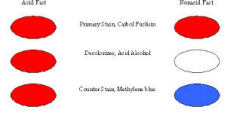
acid fast vs non acid fast
|
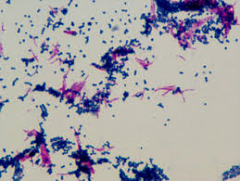
acid fast vs non acid fast
|
|
|
Acid Fast Prep
|
1. Clean and label slide
2. inoculate specimens with needle 3. Heat fix 4. Place bulbous paper over slide and cover with Carbolfuchisn (primary stain) for 15 mins 5. Remove paper and rinse h20 6.Decoloraize for about 3 secs (Acid Alcohol) 7. rinse 8.Methylene blue. 1-2 mins 9. rinse |
|
|
2 medically significant genera of bacteria Clostridium and Bacillus are able to produce
|
spores
the ability of the spores of pathogenic species w/in these genera to survive normal disinfection measures has profound implications for the food and healthcare industries as well as concerns of their use as biological weapons of war or terrorism |
|
|
Endospore technique
|
1. Clean Label slide
2. inoculate and heat fix 3. cover w/ bibulous paper 4.Malchite green (Primary) 5. steam over tea light for 15 mins 6.rinse 7.safranin for 1-1:30 8. rinse |
|
|
capsule functions:
|
1. Protection from phagocytosis
2. Adherence 3. Osmotic Barrier 4. Stored nutrients |
|
|
Capsule technique:
|
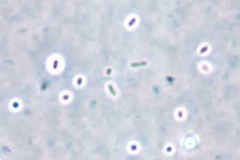
No heat fix- Heat fix causes the cells to shrink, leaving an artifactual white halo that can be misinterpreted as a capsule.
India ink (negative stain) the capsule appears as a clear halo around the bacterium as the ink can't penetrate the capusule. counter stain w/ crystal violet to stain the bacterial cell |
|
|
Many bacteria have a gelatinous coating exterior to their cell wall called a
|
glycocalyx
The glycocalyx can vary in thickness and chemical composition among different species of bacteria. |
|
|
Streptococcus pneumonia produces capsules?
|
Yes
|
|
|
Fungi can be divided into what 2 sub-categories?
|
Yeast
Fungi |
|
|
Kingdom Fungi AKA
|
Myceteae
|
|
|
Fungi reproduce by
|
spores (both sexual and asexual budding)
|
|
|
yeast reproduce
|
asexually by budding. If the bud fails to separate they can form PSEUDOHYPHAE.
note: some yeasts can reproduce sexually as well |
|
|
bacteria called strict (obligate) aerobes cannot
|
live w/o o2
|
|
|
microaerophiles
|
require oxygen but only in concetations lower that atmospheric levels.
|
|
|
facultative anaerobes
|
grow with or w/o o2, but grow much better in an oxygenated environment because they can utilize it metabolically.
|
|
|
aerotolerant
|
grow equally well with or w/o O2 because they don't utilize it for metabolism.
|
|
|
strict anaerobes
|
cannot grow in presence of O2
|
|
|
GasPak Anaerobic jar:
|
Innoculated plates are placed in the jar along w/ an envelope that produces CO2 and hydrogen gas. The jar also contains palladium pellets and a methylene blue strip as an oxygen indicator.
10ml of water is added to the gas generator envelope and the jar is sealed. In the presence of the catalyst, palladium, the hyrdrogen gas, generated by the envelope, combines w/ any free O2 in the jar, to produce water. (2h2 +O2 ----->2H20). In the absence of oxygen the methylene blue strip becomes colorless. |
|
|
Resazurin is an
|
oxygen indicatior
Rezazurin is colorless in the reduced state (when there is no free O2) but in the presence of O2 resazurin turns pink |
|
|
THYOGLYCOLLATE MEDIUM IS USED WHEN O2 TOLERANCEY IS BEING TESTED
|
Know rezasurin is pink when oxygen is detected
|
|
|
General purpose media
|
Media that supports the growth of a variety of microbes. Nutrient agar and Tryptic Soy Agar (TSA) are examples of general purpose media used in our lab.
|
|
|
Selective Media:
|
Contains dyes or toxic substances which discourage the growth of certain microbes, but supports the growth of others.
Eosin methylene blue agar (EMB) selects for Gram negative bacteria by supporting their growth but inhibits the growth of Gram Positive bacteria. Phenylethyl alcohol agar (PEA) selects for G+ bacteria by supporting their growth but inhibits the growth of Gram - bacteria. |
|
|
Differential media
|
Different microbes produce distincitive colonies (color, texture etc.) on differential media. EMB is both selective and differential because bacteria that ferment lactose (and are able to grow on EMB) produce dark purple conlonies or a metallic green sheen on the media.
|
|
|
Enriched media
|
Growth substances are added to give more luxurious growth or allow for growth of organisms that can not grow on general purpose media. For example blood and serum can be added to media to enhance the growth of human pathogens.
|
|
|
Phenylethyl Alcohol Agar:
|
-Encourages growth of G+
-Inhibits G- -Selective Agent (phenylethyl alcohol) -Not differential Phenylethyl Alcohol inhibits G(-) by breaking down their membrane permeability barrier, thus allowing influx of substances ordinarily blocked and leakage of cellular potassium. |
|
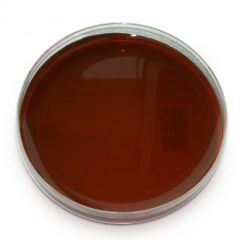
EMB
|

Eosin Methylene Blue Agar (EMB) is both selective and differential. EMB selects for G(+) bacteria. EMB also differientiates b/w lactose fermenting and nonfermenting bacteria. Lactose fermenting bacteria will produce dark purple colonies or produce a metallic green sheen on the agar. Nonlactose fermenting bacteria will form pink colonies.
E.Coli Ferments lactose. So the Plate would be + for E.coli |
|
|
MacConkey
|
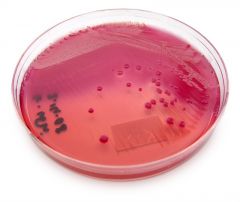
MacConkey (MacC) is both selective and differential.
(MacC) selects for G- bacteria and tends to inhibit the growth of G+ bacteria. (MacC) also differentiates b/w lactose fermenting and nonfermenting bacteria. Lactose fermenting bacteria will produce pink to red colonies. Nonlactose fermenting bacteria will appear colorless. again looking for E.coli |
|
|
PEA:
|
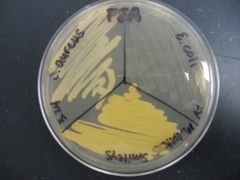
Phenylethyl alcohol agar
selects for G+ inhibits G- S.aureus G+ B. cereus G+ |
|
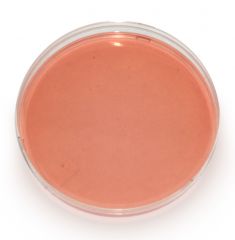
MSA
|
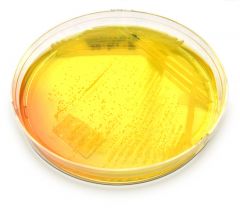
Mannitol Salt Agar (MSA) is both selective and differential. MSA contains 7.5% NaCL and selects for SALT TOERANT bacteria. MSA also contains the carbohydrate mannitol and the pH indicator phenol red.
If your unknown is able to grow on MSA and ferment mannitol it will change the color of the media from pinkish red to bright yellow. Purpose: Selects for Staphylococci, which grow at high salt concentrations; differentiates Staphylococcus aureus from other Staphylococci |
|
|
BA
|
Blood Agar
Blood agar is both enriched and differential. Blood agar is enriched because it contains 5% sheep blood cells to enhance growth. Blood agar is differential based on HEMOLYTIC PATTERNS (HEMOLYSIS: lysis of red blood cells). Beta Hemolysis: Bacteria that completely lyse red blood cells will form a clear zone around the colonies or streak line and are termined Beta (B) hemolytic Alph(a) hemolysis: Bacteria that are a-hemolytic partially lyse red blood cells and form a greenish brown zone around the colonies or streak line Gamma (y) hemolysis: Bacteria that are unable to lyse red blood cells (nonhemolytic) will make no apparent change in the blood agar around the colonies or streak line. |
|
|
this test is going to suck because why?
|
Cause its just going to ******* suck...
|
|
|
fermentation of a carbohydrate by bacteria results in
|
the production of acid as an end product
some bacteria will produce both acid and gas as end products |
|
|
Carbohydrate media pH indicator
|
phenol red
|
|
|
At neutral pH phenol red is
|
red
|
|
|
If your unknown is able to ferment the carbohydrate in the tube...
|
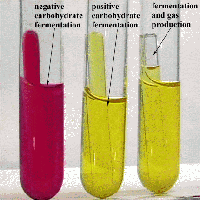
acid will be produced and phenol red will turn the media from red to yellow. If your unknown produces both acid and gas, in addition to the medium turning yellow, a bubble will appear in the Durham tube
|
|
|
Catalase production (Bacterial exoenzyme test)
|
Enzyme catalase breaks down hydrogen peroxide into water and oxygen
2H202 --------> 2H20 + O2 |
|
|
Starch Hydrolysis
|
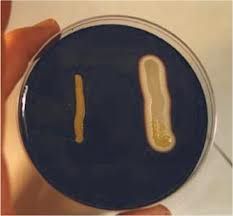
Starch is a polysaccharide which some bacteria can hydrolyze/digest by producing the enzyme AMYLASE.
Substrate ------->Enzyme ------> Product To test your unknowns ability to produce amylase, and hydrolyze starch, cover the surface of the starch agar plate around your streak line with Gram's iodine. Starch reacts w/ iodine to produce a blue-black color. If your unknown was able to hydrolyze the starch in the media no starch will be present in the area surrounding your streak line When you add the iodine, instead of a blue-black color, there will be a clear or brownish (due to the color of the iodine) zone around your streak line. If your unknown is unable to hydrolyze the starch in the media a blue-black color will appear around your streak line E.Coli S.aureus |
|
|
Casein hydrolysis
|
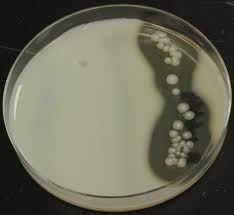
Casein is the most abundant protein in milk
Some bacteria are able to hydrolyze casein by means of the enzyme CASEINASE. Examine the area around your streak line on the skim milk agar (casein agar). If there is a clear zone surrounding your streak line your unknown is + for casein hydrolysis. If the area around your streak line is still opaque your unknown is - for casein hydrolysis. B. Cereus |
|
|
Gelatin hydrolysis
|
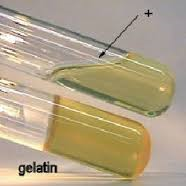
Gelatin is a large protein molecule which can be hydrolyzed by bacteria producing the enzyme GELANTINASE
Gelatin is normally solid at or below room temp but when hydrolyzed it liquefies and will remain in a liquid state even at low temp. Place the gelatin deep in the fridge for 20 mins. After 20 mins have elapsed carefully tilt the tube and check for liquefaction |
|
|
The IMViC series consists of
|
four test. The first letter of each test makes up the acronym IMViC.
I Indole production M Methyl red V Vogest-Proskauer C Citrate utilization |
|
|
indole test
|
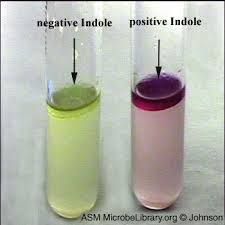
(tryptophan hydrolysis): Certain bacteria produce the enzyme TRYPTOPHANASE which breaks down (hydrolyzes) the amino acid tryptophan into the end products: indole pyruvic adic and ammonia
In this test a tryptone broth tube (containing tryptophan) is inoculate w/ the bacteria being tested and incubated. After the incubation period KOVAC'S REAGENT is added to the broth culture. Kovac's reagent contains p-dimethylaminobenzaldehyde which reacts w/ indole to produce a red/cerise color. |
|
|
Methyl red test
|
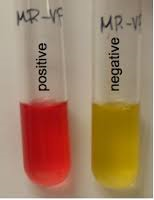
(mixed acid fermentation) uses a medium (MRVP) that contains glucose, peptone and dipotassium phosphate. Bacteria that are able to ferment the glucose and produce large amounts of a variety of acids (MIXED ACID FERMENTERS) will lower the pH of the medium to 5.0 or less.
At this low pH the methyl re indicator, which is yellow at a pH of 6.4 or above, will remain red when added to the medium. |
|
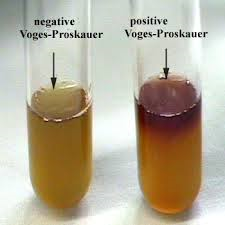
Voges-Proskauer test:
|
The Voges-Proskauer test uses the same medium as the methyl red test (MRVP) but tests for the production of ACETOIN (ACETYLMEHYLCARBINOL) a nonacid by-product of glucose metabolism. Acetoin is detected by the addition of the VP TEST REAGETNS that react chemically w/ acetoin to produce a pink or red color.
|
|
|
Citrat utilization test
|
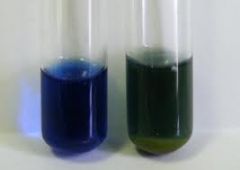
SIMMONS CITRATE AGAR contains SODIUM CITRATE as the sole carbon source. Bacteria that are able to utilize sodium citrate will produce an alkaline product (sodium carbonate) that changes the pH indicator (BROMTHYMOL BLUE) from green to Prussian blue.
|
|
|
Results Indole production
|
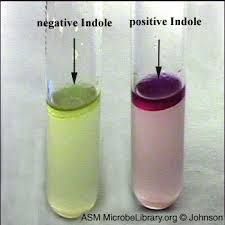
Add kovacs reagent to tryptone broth tube
Kovacs reagent will rise to surface of medium. A red layer on the surface of the medium indicates a + reacton (indole was produced) Kovacs reagent , which has not reacted w/ indole, is a yellowish color; thus a yellowish layer at the surface of the medium indicates a - reaction (no production of indole) |
|
|
Methyl red test
|
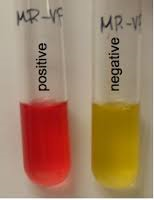
A methyl red indicator to the MRVP tube
A reddish color is + reaction and no change or a yellowish color is a - reaction |
|
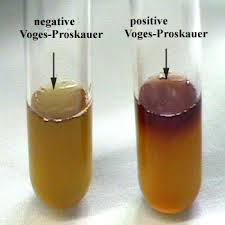
Voges-Proskauer test
|
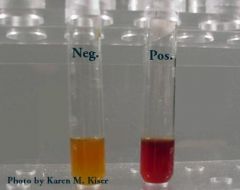
Add VP1 and VP2 to the MRVP tube ..
a pink or rose color indicates a + reaction No change or yellowish - |
|
|
Citrate utilization
|
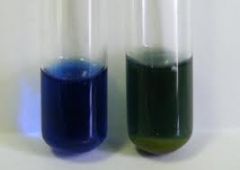
Bright blue (Prussian blue) = +
(no change -green = - |
|
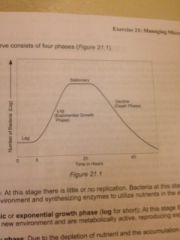
|
Lag phase: little no replication
Logarithmic or exponential growth phase: Adapted and active Stationary: No growth cause nutrients les available... toxic Decline... death... toxic no nutrients easily inhibited in logarithmic growth phase. Many antimicrobial substances act by disrupting metabolism and metabolism is maximal during the log phase. Cells are dividing rapidly so they don't form thick cell walls, well developed capsules or endospores. Bacteria cells are harder to destroy in stationary phase because they tend to have a lower metabolic rate, thick cell walls, and well developed capsules and endospores. |
|
|
some bacteria called ______________ can continue to grow in high salt environments
|
halophiles (salt loving)
|
|
|
Hydrogen ion concentration (-log [h] or pH)
|
has profound influence on growth. Microorganisms tend to have a specific range of pH within which they can grow. The pH for some microorganisms is very narrow; others may have a broad pH range in which they can survive.
|
|
|
Most bacteria grow optimally at a fairly
|
neurtral pH and are termed NEUTROPHILES.
|
|
|
acidophiles
|
bacteria that grow optimally in an acidic environment
|
|
|
alkalinophiles
|
inhabit alkaline soils and water and can continue to grow at a pH of 11.5 and a few species can grow at a pH as high as 12
|

